Volume 24, Issue 73 (6-2024)
jgs 2024, 24(73): 311-334 |
Back to browse issues page
Download citation:
BibTeX | RIS | EndNote | Medlars | ProCite | Reference Manager | RefWorks
Send citation to:



BibTeX | RIS | EndNote | Medlars | ProCite | Reference Manager | RefWorks
Send citation to:
abedi S, hanaee T, bagherzade golmakani Z. (2024). The effect of children's cognitive ability on ease of choosing a path in urban space(Case study of Lashkar Ghasemabad neighborhood). jgs. 24(73), 311-334. doi:10.61186/jgs.24.73.311
URL: http://jgs.khu.ac.ir/article-1-3692-en.html
URL: http://jgs.khu.ac.ir/article-1-3692-en.html
1- PhD Student of Urban Design, Faculty of Art and Architecture, Islamic Azad University of Mashhad, Mashhad, Iran, PhD Student of Urban Design, Faculty of Art and Architecture, Islamic Azad University of Mashhad, Mashhad, Iran , shimaabedi67@gmail.com
2- Assistant Professor of Urban Planning, Faculty of Art and Architecture, Islamic Azad University of Mashhad, Mashhad, Iran, Assistant Professor of Urban Planning, Faculty of Art and Architecture, Islamic Azad University of Mashhad, Mashhad, Iran
3- Assistant Professor, Department of Psychology, Islamic Azad University, Uniteshishabour, Neyshabur, Iran, Assistant Professor, Department of Psychology, Islamic Azad University, Uniteshishabour, Neyshabur, Iran
2- Assistant Professor of Urban Planning, Faculty of Art and Architecture, Islamic Azad University of Mashhad, Mashhad, Iran, Assistant Professor of Urban Planning, Faculty of Art and Architecture, Islamic Azad University of Mashhad, Mashhad, Iran
3- Assistant Professor, Department of Psychology, Islamic Azad University, Uniteshishabour, Neyshabur, Iran, Assistant Professor, Department of Psychology, Islamic Azad University, Uniteshishabour, Neyshabur, Iran
Abstract: (4878 Views)
The importance of studying development in the field of child psychology is crystallized. On the other hand, cognitive development is a source of awareness in the field of children's development and has a double effect on the process of wayfinding children. Paying attention to this in urban spaces can make it easier for children to successfully wayfinding. The purpose of this study is to develop factors affecting the ease of wayfinding children in urban spaces with emphasis on cognitive abilities. The research method is applied in the present study. In this regard, in order to collect data, field observations, questionnaires and site visits have been used. The sampling method is random using Cochran's formula and the questionnaire was completed by 106 children in the age range of 10-12 years and 106 children in the age range of 12-14 years. Data analysis to analyze the routing pattern of children affected by cognitive development in Lashgar neighborhood has been calculated quantitatively by factor analysis using LISREL software. In data analysis to evaluate the relationship between wayfinding and cognitive development after data collection, the data were analyzed by statistical methods of Ti-dependent test, Kolmogorov-Smirnov hypothesis test. Based on the analysis of cognitive abilities in the navigation process of children, the results indicate that the elements of the guide and used in navigation are different in two age groups, and the age group of 12-14 years has an analytical mind, and in contrast to the group of 10-12 years, it is searching and Paying attention to secrecy determines the path. Children in the second age range mostly mentioned the color of the facades, the shape of the building and the buildings that have a distinctive form and function, also the children in the first age range pointed to the distinctive signs that have a distinct body compared to other buildings in the neighborhood.
Keywords: Cognitive development, child, wayfinding, Lashgar neighborhood.
Type of Study: Research |
Send email to the article author
| Rights and permissions | |
 |
This work is licensed under a Creative Commons Attribution-NonCommercial 4.0 International License. |

This work is licensed under a Creative Commons — Attribution-NonCommercial 4.0 International (CC BY-NC 4.0)





